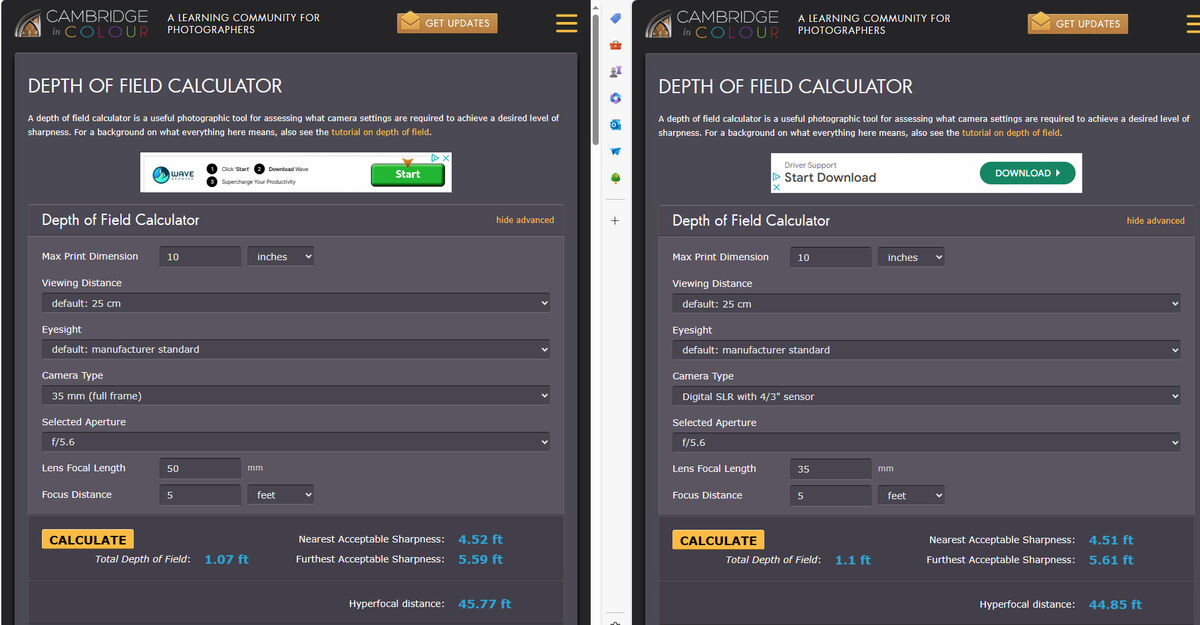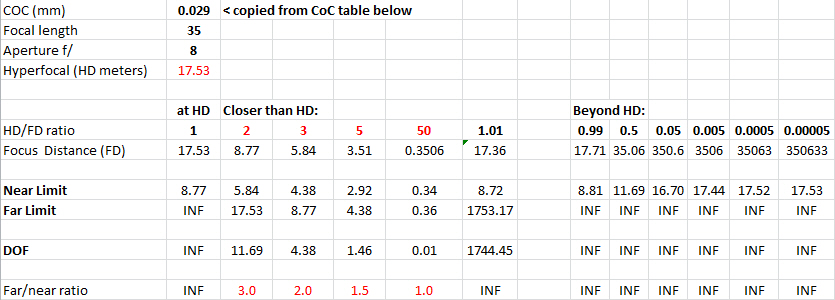Posts for: selmslie
May 4, 2024 17:04:19 #
User ID wrote:
Then the f/stop must change.
It doesn't.
May 4, 2024 16:56:51 #
BebuLamar wrote:
Nope same f/stop
for example if you calculate the DOF for the 50mm, f/5.6, focus at 5 feet. The DOF is the same for the M43 of 35mm, f/5.6, focus at 5 feet.
Since the crop factor of the M43 is 2 so the formula is 50x1.1414/2
for example if you calculate the DOF for the 50mm, f/5.6, focus at 5 feet. The DOF is the same for the M43 of 35mm, f/5.6, focus at 5 feet.
Since the crop factor of the M43 is 2 so the formula is 50x1.1414/2
It's pretty close but the crop factor and the CoC ratio are not exactly 2x and the M43 has a different aspect ratio.
Because of the difference in aspect ratio, the field of view has a 2x factor horizontally but 1.78 vertically.
Here is the list from the spreadsheet:
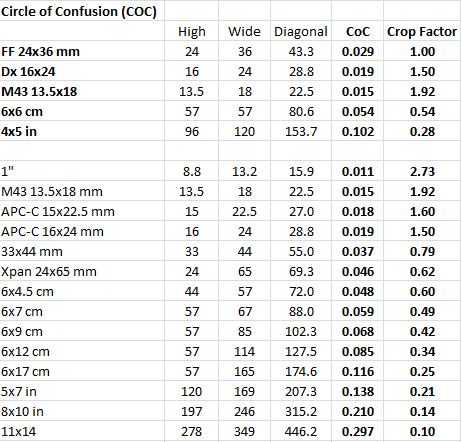
May 4, 2024 14:39:31 #
User ID wrote:
Dont worry that "maybe its only close".
"Only close" is what DoF is all about.
"Only close" is what DoF is all about.
We can calculate until we are blue in the face but it all boils down to the classic definition of the circle of confusion (CoC), "The circle of confusion is a bunch of photographers arguing about the meaning of depth of field."
Aside from having to guess how good the viewer's eyesight is, the one thing we cannot control is how close they will get to view the image. And they will probably not even bother to get too close unless they run out of reasons to conclude that the image sucks.
Visual acuity factors

May 4, 2024 11:07:22 #
selmslie wrote:
That's not entirely correct. As you focus beyond HD, the DOF indeed remains infinite. But if you focus at infinity, the near limit of the DOF is at HD.
So the statement should read, "∞:(something greater than HD/2)". And the distance from HD to ∞ is ∞.
So it is not a mistake to focus at infinity if there is nothing of interest between the camera and HD.
So the statement should read, "∞:(something greater than HD/2)". And the distance from HD to ∞ is ∞.
So it is not a mistake to focus at infinity if there is nothing of interest between the camera and HD.
Here is some more information on the ratios of focal distance to HD and how they affect the distribution of DOF closer to and further from the focal distance. I have attached the spreadsheet if you want to explore how this works for your own camera.
The basic inputs are:
- the sensor's CoC (the spreadsheet includes a table with sensor sizes from a one inch sensor to 11x15" film.
- lens focal length
- aperture
That is used to calculate the hyperfocal distance.
The HD/FD ratio is 1 if you focus at HD, 2 at HD/2, 3 at HD/3, etc.
FD is calculated from the HD and the HD/FD ratio.
The near and far DOF limits and total DOF are then calculated.
Finally we see the ratios of the DOF beyond FD to DOF nearer to the camera than FD (Far/near ratio):
- Focused at HD, the ratio is infinite
- At 1/2 HD, the ratio is 3:1
- At 1/3 HD, the ratio is 2:1
- At 1/5 HD, the ratio is 1.5:1
- At 1/50 HD (close to macro), the ratio is 1:1
Those ratios are the same no matter what you enter for CoC, focal length or aperture.
If you focus beyond HD, the far/near ratio is always infinite. If you focus at infinity, the near limit for the DOF is always HD.
May 3, 2024 22:14:16 #
selmslie wrote:
And once you pass HD, the ratio becomes ∞:(something less than HD/2) but the DOF remains infinite.
That's not entirely correct. As you focus beyond HD, the DOF indeed remains infinite. But if you focus at infinity, the near limit of the DOF is at HD.
So the statement should read, "∞:(something greater than HD/2)". And the distance from HD to ∞ is ∞.
So it is not a mistake to focus at infinity if there is nothing of interest between the camera and HD.
May 3, 2024 16:46:57 #
JD750 wrote:
It's always good to be open to new ideas, but also you say 1/3 has been working and there is another saying which is "if it ain't broke don't fix it." LOL.
Everyone has a process, nothing wrong with that. Myself I just look thru the viewfinder and use DOF Preview to evaluate the depth of focus.
Everyone has a process, nothing wrong with that. Myself I just look thru the viewfinder and use DOF Preview to evaluate the depth of focus.
The DOF preview never really worked because you can't judge the DOF on your camera's LCD or in the viewfinder of an SLR/DSLR. It's even difficult to see on the ground glass of a medium or large format film camera.
The 1/3-2/3 (1:2 ratio) "rule" only applies when your camera is focused at 1/3 of the hyperfocal distance. As you focus closer, the ratio approaches 1:1 and eventually gets there at true macro distances.
At the hyperfocal distance (HD) the ratio is ∞:HD/2 making the DOF infinite.
And once you pass HD, the ratio becomes ∞:(something less than HD/2) but the DOF remains infinite.
Some lenses can focus a little past infinity which might vary with temperature to avoid a hard stop.
May 3, 2024 16:25:37 #
JD750 wrote:
This question is for selmslie. I am seeing here the DOF calculators could be wrong. And shame on them for that.
Here is the question: How can we tell if the one we are using is wrong?
Here is the question: How can we tell if the one we are using is wrong?
Compare it to the one from Cambridge in Colour which has been thoroughly tested and documented before it was published.
But the numbers may not tell you anything useful if you are using a camera with a 1" sensor or smaller. That's so small that you can't see anything beyond the DOF (out of focus, OOF) unless your camera was very close to the subject and using a relatively long focal length and a very wide aperture.
A more extreme situation is when you use a smartphone which has an even smaller sensor. Despite the apparent wide fixed aperture, it's almost impossible to see the limits of the DOF. I showed this in https://www.uglyhedgehog.com/t-805958-11.html#14598145 along with a way to compare the iPhone to full frame camera.
Another factor with very small sensors is whether you are viewing the entire original (uncropped) image from a normal viewing distance (NVD) which is about the same as the image diagonal. You might only see OOF issues if you pixel peep, which artificially brings you much closer than the NVD, and there are a lot of MP in the original image (more than 8MP).
Anything posted online, especially when it's cropped or reduced in size, can be misleading - either out of ignorance or deliberate fraud.
May 2, 2024 16:38:01 #
Longshadow wrote:
One of the nicest things about an engineering background is a well developed analytical ability.
Comes in very handy.
Comes in very handy.
Maybe a chicken and egg situation. Your success as an engineer may come from an aptitude for analytical thinking.

May 2, 2024 16:26:48 #
OldCADuser wrote:
Oh, I still considered myself an engineer as the software company that I went to work for was selling software TO engineers and which they used everyday, and my role in the company was to work with these engineers to make sure that we were meeting their needs and keeping up with what we were offering them and that we were keeping up with what they were doing with our software, and so as to maintain my credibility I retained my professional engineering license up until I retired 8-years ago.
My engineering background gave me som credibility but I moved into mathematical modeling and financial analysis.
May 2, 2024 16:10:50 #
OldCADuser wrote:
Gee, that sounds like my life story.
In 1980, after working 14-years as a Mechanical Engineer, I changed jobs and joined a software company where I finally made some real money. 36-years later I retired. And while I never worked in a camera store, I did work a second job one summer selling radios and small appliances at an Arlan's department store (now there's a blast from the past).
In 1980, after working 14-years as a Mechanical Engineer, I changed jobs and joined a software company where I finally made some real money. 36-years later I retired. And while I never worked in a camera store, I did work a second job one summer selling radios and small appliances at an Arlan's department store (now there's a blast from the past).
That scenario may be more common than we might think.
My father started as a civil engineer and so did my daughter. Both of them moved on to better jobs. My son skipped the engineering step, went straight to business and is earning more than either of us.
I guess the lesson is, if you want an interesting career, become an engineer. But if you want to get rich, don't.
May 2, 2024 13:47:13 #
Ysarex wrote:
I understood the subject decades before the Internet and DOFMaster came into existence. In fact it was the very 1/3 DOF rule that Frank brought up that solidly proves you were wrong that started me off on an understanding of DOF.
How did Frank's statement prove that I was wrong about anything? All I did was to recommend the DOF calculator from Cambridge in Colour. I said nothing about the 1/3 assumption.
Ysarex wrote:
It was the early 1970s and I worked in a camera store. I had by then learned that 1/3 rule-of-thumb and was in the process of showing a customer the DOF calculator on a lens. In doing so I recognized the imprecision in the 1/3 rule and later asked a senior member of the staff. He reached behind his desk and brought down a 1950's vintage copy of The Leica Manual and handed it to me saying, do the math. I did.
By the 1970s I had been working as a mechanical engineer for a decade and in the process of changing my career over to software engineering where I finally made some real money. I was never a clerk in a camera store.
As for doing the math, I have just proven that I can still do the math. You have proven nothing. You were not even able to catch the error that DOFMster made that doubled the hyperfocal distance.
One of us is a mathematician, engineer and programmer who can understand the issues clearly. The other is an amateur with a questionable memory and a bad attitude.
I will respond to anyone else who would like to discuss the subject, but I will no longer respond to you.
May 2, 2024 12:24:39 #
Ysarex wrote:
I don't.
In the photo of grave markers I didn't use a DOF calculator. I did apply my useful understanding of how DOF distributes around the focus plane and rather than focus on the closest marker to the camera which would have wasted DOF or just used the center focus point in the camera which may have not extended DOF to the closest marker. I chose to focus on the marker behind the closest marker which proved effective and satisfactory.
In the photo of grave markers I didn't use a DOF calculator. I did apply my useful understanding of how DOF distributes around the focus plane and rather than focus on the closest marker to the camera which would have wasted DOF or just used the center focus point in the camera which may have not extended DOF to the closest marker. I chose to focus on the marker behind the closest marker which proved effective and satisfactory.
I did not suggest that you used a DOF calculator to guide you in taking the picture.
But if you relied on DOFMster to understand the subject, you could be incorrectly influenced by what you learned.
May 2, 2024 11:54:41 #
Ysarex wrote:
Fine. No big deal. My favorite DOF calculator is PhotoPils but DOFMaster is the fastest and easiest to use.
Calculator errors don't alter the visible results in the photos. The photo of the grave markers remains a good example of applying the useful understanding of DOF distribution to effectively place DOF in a photo.
Calculator errors don't alter the visible results in the photos. The photo of the grave markers remains a good example of applying the useful understanding of DOF distribution to effectively place DOF in a photo.
If you base your assumptions on information from a faulty DOF calculator, you are bound to make the wrong choices when it comes to deciding where to focus.
Below is another reason why Cambridge In Colour is a good source for information. It shows that your 20MP 1" sensor is diffraction limited at f/5.6. You would need to open the aperture to f/4 or drop down to a 12MP sensor to avoid this.
But I would not fret over whether the aperture is diffraction limited, especially with such a small sensor. It's not likely that it's going to show up with your built-in zoom lens.
But with a full frame 24MP sensor and a very good lens it might matter if you go beyond f/11. At 45.7MP, f/8 might be the limit.
The only reason I mention diffraction limit is because diffraction might make stuff near the DOF limits look like they are fuzzy.
Personally, I would not consider a compact camera since I can get perfectly fine snapshots from my iPhone or even my X100T. But when I want anything better than a snapshot, I will use a 24MP or 45.7MP camera and a good lens.
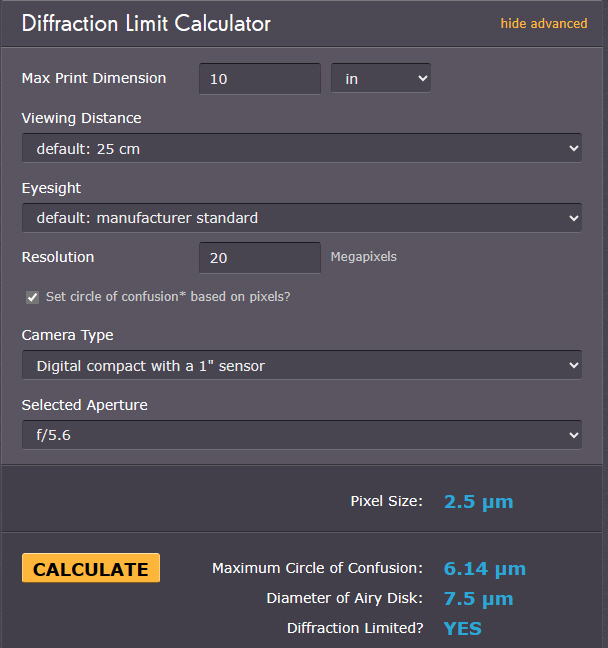
May 2, 2024 10:16:42 #
Ysarex wrote:
Apparently we have two conflicting DOF calculators. It happens. So you're not wrong about HD and neither am I. Answer could well be in the middle -- not worth chasing. DOFMaster reports the value it's using for CoC Cambridge in Colour doesn't.
If you have been relying on DOFMaster, that would explain your confusion. I found several errors in their logic so I don’t trust them although the can probably do alright for full frame and APS-C.
The spreadsheet I just uploaded shows five different versions of COC based on visual acuity. For simplicity I just use image diagonal/1500.
May 2, 2024 09:22:33 #
selmslie wrote:
Incidentally, the iPhone 15 Pro at 48mm equivalent at a crop factor of 7 has a hyperfocal distance of 6.35 meters, almost the same as your Canon. You could have captured the same image as with your Canon but at 12MP. Since you downsized it to about 2.65MP for posting, either one would have produced about the same result.
Here is the equivalence between an iPhone and a full frame (24x36mm) camera.
I don't compare the iPhone directly to other formats but I have a way to compare full frame to a series of formats from APS-C (1.5) up to 8x10 including a couple of medium format digital sizes.
I also wrote a DOF calculator where I can vary the calculation of COC based on several popular assumptions.
For more on this topic, see Smartphone Depth of Field (DoF) With a Full Frame Camera
Sample results for one of the iPhone 15 cameras
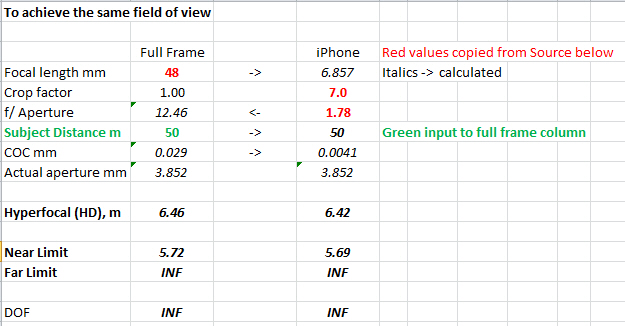
And here is the download for the spreadsheet, updated for the iPhone 15
Attached file:
(Download)
